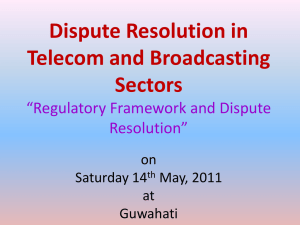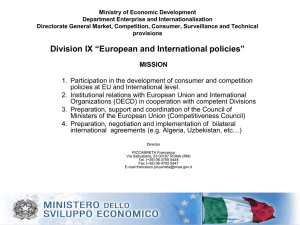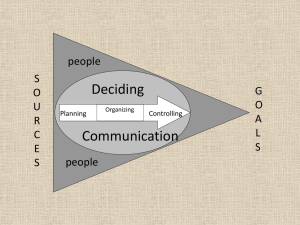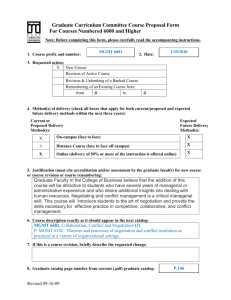NUZIP Industrial Communications Systems Standards negotiation
advertisement
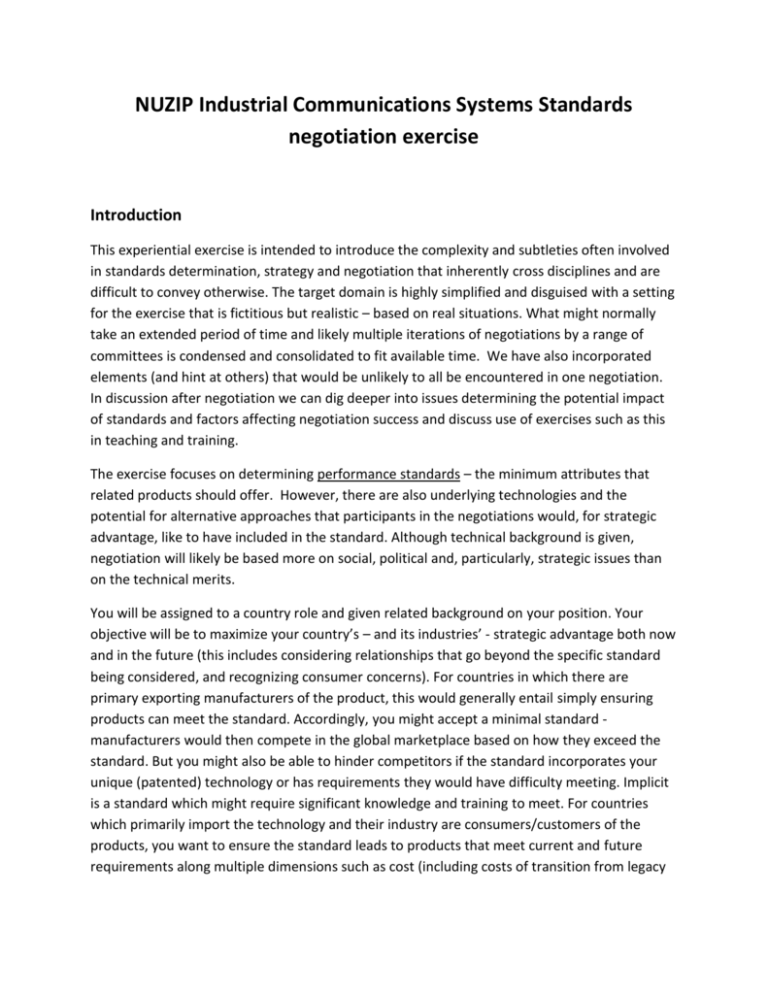
NUZIP Industrial Communications Systems Standards negotiation exercise Introduction This experiential exercise is intended to introduce the complexity and subtleties often involved in standards determination, strategy and negotiation that inherently cross disciplines and are difficult to convey otherwise. The target domain is highly simplified and disguised with a setting for the exercise that is fictitious but realistic – based on real situations. What might normally take an extended period of time and likely multiple iterations of negotiations by a range of committees is condensed and consolidated to fit available time. We have also incorporated elements (and hint at others) that would be unlikely to all be encountered in one negotiation. In discussion after negotiation we can dig deeper into issues determining the potential impact of standards and factors affecting negotiation success and discuss use of exercises such as this in teaching and training. The exercise focuses on determining performance standards – the minimum attributes that related products should offer. However, there are also underlying technologies and the potential for alternative approaches that participants in the negotiations would, for strategic advantage, like to have included in the standard. Although technical background is given, negotiation will likely be based more on social, political and, particularly, strategic issues than on the technical merits. You will be assigned to a country role and given related background on your position. Your objective will be to maximize your country’s – and its industries’ - strategic advantage both now and in the future (this includes considering relationships that go beyond the specific standard being considered, and recognizing consumer concerns). For countries in which there are primary exporting manufacturers of the product, this would generally entail simply ensuring products can meet the standard. Accordingly, you might accept a minimal standard manufacturers would then compete in the global marketplace based on how they exceed the standard. But you might also be able to hinder competitors if the standard incorporates your unique (patented) technology or has requirements they would have difficulty meeting. Implicit is a standard which might require significant knowledge and training to meet. For countries which primarily import the technology and their industry are consumers/customers of the products, you want to ensure the standard leads to products that meet current and future requirements along multiple dimensions such as cost (including costs of transition from legacy systems and enabling or constraining foundation for future application) and ease of use (import, installation, operation and maintenance). General Background 5 countries have come together to negotiate a new performance standard related to industrial (particularly manufacturing) communication systems that allow machines and operators to gather and exchange data, supporting operations. The core technology family in these systems is referred to as NUZIP. Manufacturing companies are continually challenged to improve efficiency with consistent quality while employing multiple machines on the factory floor. Companies also seek to improve communication between plant and business systems enhancing data collection, dissemination and analysis. There is also pressure to enhance interconnection with customers as well as suppliers and alliance partners. The number of devices calling for interconnection is growing astronomically. Companies must respond to, or - even better - predict and avoid disruptions and be flexible and agile to react to rapidly changing market conditions. Beyond operational control requirements, the demands for energy usage data from emerging smart grid initiatives, and global distribution increasing the distance between devices, as well as number of devices on a network are exacerbating demand for increased speed and associated bandwidth. The potential from continually evolving IT technologies, related stakeholder expectations, also push for significantly increased speed and accuracy of data throughput. But the combination of increased speed and interconnections can lead to complexity and heightened security threats. Competing approaches are in various stages of development. Companies are already pushing the limits of current systems but are delaying investment pending a standard (the pressure to establish a standard is high.) Trade-offs In deciding on a communication system, companies consider a range of factors that should be reflected in the standard and consideration of reference to proprietary technologies. It is important to recognize that these variables can be closely interrelated. There are a number of other factors that would actually come into play but these are the ones this short exercise will consider. System-wide speed of throughput Determinism – refers to the speed at which a response is returned indicating data has been received by system components as required, and the extent to which this is consistent, accurate and can be predicted. Transmissions of data can go to multiple receiving nodes (which relates to system complexity) before arriving at the right one. For precisely programmed high-speed machining operations, such delay and uncertainty can be critical. The value of rapid transmission is significantly reduced if it is not deterministic. Accordingly systems can be viewed in terms of the combination of data throughput speed and reaction time (determinism) as real (usable) speed. Complexity - this includes how technically difficult it is to set up, program and maintain the system and relatedly, how much training is required Options for standard Standards should reflect a combination of throughput speed and reaction time (deterministic) increased speeds and decreased reaction times can be assumed to allow for/include lesser levels). DATA THROUGHPUT SPEED 10mbs (low) 100mbs (medium) 1 gbs (high) REACTION TIME (DETERMINISTIC) 100ms (slow) Less than 10ms (medium) Less than 1ms (fast) The lowest speed and highest reaction time may be adequate for current basic process monitoring. Mid-levels may allow for tooling machine control systems. The highest end is already required for robotic/complex motion control and for data collection and sophisticated real time analysis. The clear trend is for growing demand for higher speeds and faster reaction times. Overview of who is at the table Participants in the negotiation come from 5 countries (A-F) representing competitors (manufacturers) and current and potential customers. Each country participating in the negotiations has different objectives based on their local industries, economic and development status, relationships and other concerns including related security. There is also a “Chair” which does not come from any of the 5 negotiating countries. NUZIP was originally developed by manufacturers in Country A which continues to lead its market and evolution. Systems using NUZIP, and derivative approaches in varying configurations including with 3rd party devices (NUZIP was not initially patented), have performed very well for years with modest enhancement allowing use in basic but also more advanced applications, It is fully accepted in the global market. Indeed many companies such as those in Country B compete only in applications at the lower speed and, without significant support could not use the higher speeds. With the continued advances in the technology and complex network set up, it has become more and more difficult to switch to a different technology once a form of NUZIP is deployed. Particularly advanced manufacturing processes (such as used by industry in Countries D and E) with applications running at a higher speed, but also a broadening spectrum of industry looking forward, are urgently pushing for further development of NUZIP and a related formal standard that could support emerging applications and network investment planning. The market for higher real speed is expected to be more lucrative than low-speed. There is some concern because when the lower speed models were ramped up significantly in the past, they became unstable. Only one manufacturer – in Country A – has demonstrated an approach that has performed without problems at high real speeds (well in excess of 1gbs and with determinism approaching 1 ms) and this has now been patented and is being launched. There may be some unspecified security vulnerability in Country A’s approach but these are not considered to be serious. Country C manufacturers are close though no timeline has been set for product introduction. In fact, though not yet clear, their approach may have technical advantages. In particular, Country C claims their approach is more secure than that of Country A. Country A’s systems work best with Country A certified related equipment and the systems are quite complex. It is expected similar constraints will apply to Country C eventual products. At least this iteration of high speed NUZIP (both Country A and Country C approaches) is indicated to be backward compatible (usable at lower speeds.) Country A and Country C approaches are not compatible with each other requiring potential significant switching cost to change later. Initiated by Country A, negotiations will attempt to develop a new performance standard which would apply to the technology (now only a de facto/market determined standard exists at speeds of 10-100mbs with reaction times over 10ms.) Consistent with the rules of the standard body coordinating the negotiations, the high speed NUZIP patent holding firm in Country A has agreed to charge very low or even zero royalties to firms adopting the standard if their approach is incorporated (referenced) in the standard (the level can be negotiated as part of the standard setting process but would not be specified in the standard.) If a standard is not established now, it will be put off until next year. INITIAL DRAFT STANDARD PROPOSED BY COUNTRY A 1. The standard for NUZIP will be 10 mbs -1 gbs throughput speed with less than 1 ms reaction time. 2. The technology will be based on (reference) the Country A approach including its level of safety and security. 3. It will be backward compatible and support use at lower levels. NUZIP Standard negotiation exercise Negotiation Process, Instructions and Rules (DISCUSSION OF LESSONS LEARNED WILL FOLLOW NEGOTIATIONS) TASKS • Assess needs and concerns; define basic optimal goal and strategy – both ideal and fallback positions - taking into account your primary country stakeholders’ positions i.e. the technology manufacturer, the manufacturing users and global market (export) opportunity, the concern for security, existing national trade agreements or defacto partnerships. • Identify and assess potential positions and foundations of other participants, refine your strategy and fall-back negotiation goals and strategies based on potential responses from other countries in the negotiation. • Pursue strategy through both open committee session and, as appropriate and necessary, private interaction with other countries during the break STAGES 1. 15 minutes preparation within groups Use this time to review role assignments and consider strategy. You may select a spokesperson or any one of you may speak during the negotiation. While you cannot embellish or change the technology, you can and should be creative in anticipating other parties’ positions (refining assessment as negotiations proceed), how you can address them (you may, for example, offer training – although this, of course, carries a cost, safety inspections etc.) and how they might respond. What is critical to you? What will you reveal or not – and when about your interests and thinking? What do you need, how urgently? Who might be allies? Who might be enemies? 2. 20 minutes formal negotiation: each group will make brief opening statements and then offer further comments and counterpoints/questions with permission of moderator. 3. 15 minute break (you may use this time for developing further your own strategy based on knowledge from the formal negotiation and conducting informal interactions (one or more of your team meeting with one or more members from other country groups for clarification of their position, or potential alignment with your goals) 4. 15 minutes formal committee negotiation resumes 5. 15 minute break (you may use this time for developing your own country positions and conducting informal interactions with other groups) 6. 10 minutes final formal committee negotiations 7. Present your experiences in post-negotiation discussion VOTING PROCEDURES The negotiation will be administered by a designated Chair (with assistance from a Secretariat). The Chair can call for a vote at any time. Voting for approval of a standard will follow typical rules with a consensus determined by agreement of 2/3 of voting participants present – for this exercise, meaning 3 of 5 must agree. Consensus is determined by the Chair. SUMMITTING DRAFT STANDARDS An initial draft has been prepared by Country A. Any participating country may submit a new or revised draft to the Chair. This should be in advance of open sessions but revisions may also be proposed during the open sessions. For easy reference each line of a draft should be numbered. At his/her discretion, the chair may consolidate similar drafts or reject a draft if language is too confusing. If he/she believes it would help to achieve consensus, the Chair may recall an earlier draft for a revote. With these caveats, the Chair will present each draft for comment and vote within the indicated total session time frames (time for an individual session may be extended at the Chair’s discretion if he/she feels an agreement is imminent or a key disagreement point is being clarified.) If a standard is not established in the current set of negotiation sessions, it will result in a postponement of the standard for at least one year. ADDITIONAL GUIDANCE Though a single standard is much preferred, if one cannot be established, as a fall back, the standard may be split with variation for different specific applications, be phased in, or be contingent on other negotiations but language must be very clear to avoid reducing the quality of the standard and causing market confusion. You may (and probably will need to) embellish your position, offer and claims, but keep in mind that you will encounter the same countries in other related or unrelated negotiations which are potentially equally or even more important for your objectives and anything beyond the information you are given for the technology and your position may be challenged and “come back to haunt you” in the form of damage to reputation, useful relationships or poor response in future negotiations.





